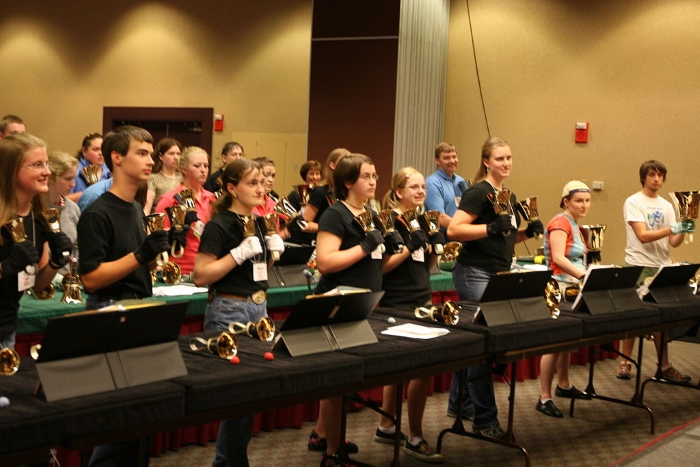An introduction to: Handbell ringing
After looking at Barbershop, Wind Bands, Samba and Brass Bands, we are now focusing on Handbell ringing. How are they played? Why do they create such close-knit groups? And where can you go to get started?
What is handbell ringing?
When people think of handbells, the image that most often comes to mind first is the kind of bell used by a town crier, or for the older generation: the bell that was rung in the school playground to signify that it was time to come back in for more lessons. In other words, a bell that can be held in the hand, and is rung to attract attention. But the bells used in handbell ringing, whilst initially they look similar, are in fact slightly different.
A handbell is rung by grasping it by the handle and moving the wrist, causing the clapper inside (which is on a hinge) to strike the outside of the bell, producing the sound. The type of bell used by a town crier has a clapper that can move in all directions (the hinge being a ball), but the bells used in handbell ringing have clappers that only move in one plane (side to side), allowing the player greater control as the bell can only sound when it is moved in one of two directions.
The note produced by a handbell depends on the size of the bell: the pitch of the bells can be fine-tuned by shaving the metal. A handbell group (known variously as a team, ensemble, choir or orchestra) will have a set of handbells covering all the notes over 2 or more octaves (including all the sharps and flats!). They play these together and in sequence to create a piece of music, complete with melody and harmony.
Because so many different bells are needed, you’ll often see handbell ensembles performing from behind tables on which all the bells are placed. Ringers can then put down and pick up bells as they are needed, and they can also use the tables themselves to create other effects. The tables are covered in a thick layer of foam, which helps to protect the bells from damage as they are lifted and lowered in quick succession.

Photo: Area X Handbell Practice, by Jeff Muceus
Where do handbells come from?
Originally handbells were useful for tower bell ringers to practice ringing the changes on – rather than practicing constantly on the church bells which might well have disturbed their neighbours! Handbell ringing became part of the church service as a result, before expanding to become a community activity.
Today, fewer churches have handbell groups and so they are less visible in communities across the UK. In the USA and Japan however, where handbells are taught in schools and universities as part of the curriculum, community handbell groups are popular.
Why do handbell ringers come in teams?
Because a player only has two hands, there is a limit to how many bells they can hold and therefore play. The traditional method is to hold one bell in each hand, though some players can play with two and sometimes three bells in each hand. However this still limits the number of notes that a player can produce at any one time, so unlike an orchestral instrument, each player is usually responsible just for 2 or 4 notes (and their associated sharps/flats), and they must play those notes every time they come up in the music.
This can make it difficult to create a sense of continuity in a piece of music, so lots of practice and precision is needed to make this work – however the overall effect is that the entire ensemble operates as one instrument.
What techniques are used in handbell ringing?
There are lots of different ways of playing handbells:
- Off-table – where you ring the bell as you lift it off the table.
- Off-shoulder – where you hold the bell to your shoulder and ring it by moving it away from your shoulder.
- Four in hand – when you hold two bells in each hand but at different angles, so that the clappers move at right angles to each other. Moving the hand in one direction makes one of the bells ring, and moving it in another direction makes the other ring.
- With mallets – handbell ringers don’t just play the bells by moving them by hand, they can also hold them in the air or position them on a table in order to strike them with a mallet.
- Damping – different methods of damping can be used to observe note values and to produce different sounds, such as holding the bell against a soft surface/table immediately after ringing.
- Plucking – the name given to the technique of moving the clapper with your fingers to make it strike the bell, rather than ringing it by holding the handle.
How is handbell music notated?
Many handbell ringers read off notated music which looks a bit like piano music, as it has a treble clef and a bass clef stave. However some ringers read from number charts, only ringing their bell(s) when the appropriate number comes up.
Just as for standard orchestral instruments, notated handbell music also contains symbols that give direction on how to play the bells in terms of damping, plucking, shaking, and many other effects.

There are also ways of notating for other related instruments, such as chimes (which are frequently found as part of a handbell group) and for percussion, which is notated the same as an orchestral percussion part would be.
What about the practicalities of keeping and maintaining the instruments?
Good question! A full set of handbells is quite a large thing to transport, and whilst some bells are small and easy to move, some of the lower (bass) bells are as big and heavy as a tuba! When they are all wrapped in their protective cloths or enclosed in their cases, they become quite bulky items to transport.
On top of that, you need foam pads of three quarters of an inches thickness to put on top of tables (many groups take their own with them to ensure they have some that meets their needs), and any mallets required, not to mention music and music stands. It all adds up to a lot of gear and you need a large vehicle to be able to accommodate even a fraction of it.
Handbells are also expensive to purchase, as there are very few makers of these instruments. However handbells are very durable instruments, and provided they are properly cared for will last for many years with minimum maintenance.
What do handbells sound like?
Listen to our playlist to hear! And whilst you’re watching, see if you can spot some of the different ways of ringing mentioned above.
How do I get involved?
To find a performance near you, check our events calendar. To find a handbell group to have a go, try our Find a group tool. If you don't see any results near you, get in touch with the Handbell Ringers of Great Britain, who will be able to point you in the right direction.
Most groups welcome beginners and will provide the instruments and music for you.
We hope you find this Making Music resource useful. If you have any comments or suggestions about the guidance please contact us. Whilst every effort is made to ensure that the content of this guidance is accurate and up to date, Making Music do not warrant, nor accept any liability or responsibility for the completeness or accuracy of the content, or for any loss which may arise from reliance on the information contained in it.

